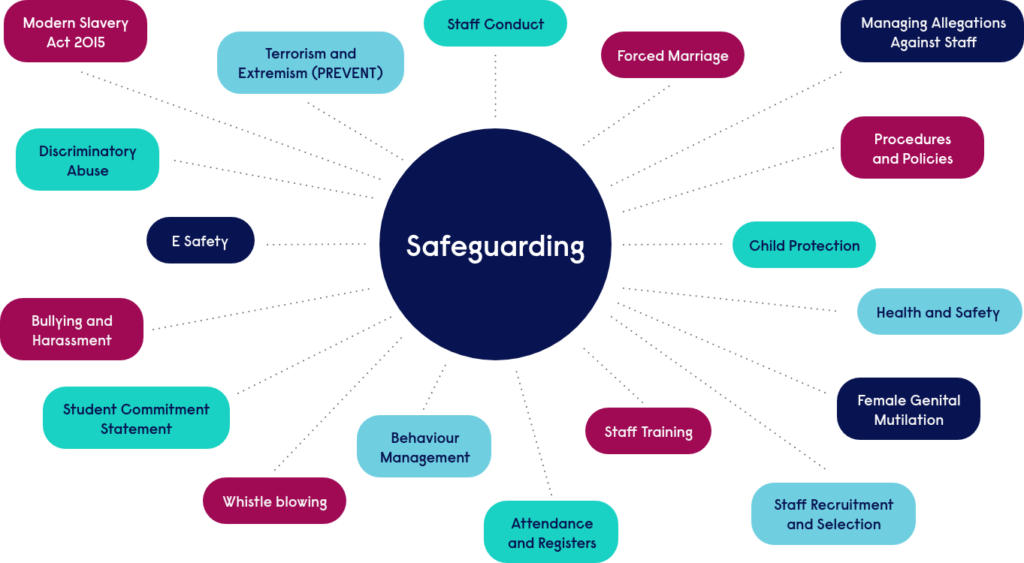Table of Contents
Introduction
Safeguarding in schools is a comprehensive approach to protecting children from various forms of harm, ensuring their well-being and providing a safe and secure learning environment. It encompasses a range of measures and practices to protect students from harm, abuse, neglect and exploitation that could jeopardise their physical and mental health, safety and well-being.
What is Safeguarding?
At its fundamental level, safeguarding encompasses the actions and measures taken to promote the well-being of children and shield them from harm. This includes preventing damage from occurring in the first place and responding appropriately if it happens.
Safeguarding is about implementing strict measures and creating a culture of safety, respect and care where children can grow, learn and develop positively. It is a broad concept that encompasses various elements, including child protection.
Child protection is a specific component of safeguarding, focusing on measures to prevent and address cases of child abuse. It also involves ensuring that children have a safe physical environment, access to secure online spaces and protection from bullying and harassment.
Why Is Safeguarding Important?
Children spend significant time in educational settings, which should be places of safety and growth, not fear or harm. Safeguarding is crucial because it:
⦁ Protects children from harm and abuse, which can have profound and lasting impacts on their physical and mental health, well-being and development
⦁ Ensures children have a safe and nurturing environment to learn and where they can thrive and reach their full potential
⦁ Builds trust and confidence among parents, carers and the broader community that the school is safe for children
⦁ Complies with legal and ethical obligations to protect children and promote their well-being
⦁ Helps identify and support children who may be at risk of harm or who have suffered damage, ensuring they receive the appropriate care and support
What Are the Duties of Schools in Safeguarding Children?
Schools have a legal and moral obligation to safeguard and promote the welfare of children. They must:
⦁ Implement comprehensive safeguarding policies and procedures that align with legislation and standards
⦁ Encourage staff to undergo child protection and safeguarding training courses so they can recognise signs of abuse and know how to respond to disclosures and report such incidents
⦁ Conduct comprehensive background checks and ensure that all adults working or volunteering in the school do not pose any risk to children
⦁ Create a safe school environment that protects children from physical, emotional and sexual harm, as well as bullying, discrimination and harassment
⦁ Work closely with external agencies, such as social services, police and health services, to ensure a coordinated approach to safeguarding
⦁ Ensure that children and their families have access to appropriate support services if they are experiencing difficulties or are at risk of harm
⦁ Promote an open and transparent culture where children feel safe to express their concerns and where their voices are heard and taken seriously
⦁ Appoint a senior staff member as a Designated Safeguarding Lead (DSL) to oversee safeguarding efforts within the school.
How to Promote Safeguarding in Schools?
Promoting safeguarding in schools requires a collaborative and proactive approach. Some ways to encourage safeguarding include:
⦁ Education and Training: Provide staff and volunteers with education and training on safeguarding policies, procedures and best practices. Enrolling them in the
⦁
Safeguarding Children Level 2 online course is a great way to equip them with essential knowledge about safeguarding policies, signs of abuse and procedures for handling disclosures and reporting concerns.
⦁ Clear Policies and Procedures: Develop clear, accessible and well-communicated policies and procedures that outline the school’s commitment to safeguarding and the steps to take if there are concerns. Ensure these policies are regularly reviewed and updated to reflect current laws, guidelines and best practices.
⦁ Designated Safeguarding Lead (DSL): Appoint a DSL trained to coordinate safeguarding efforts, provide support and guidance to staff and liaise with external agencies as necessary.
⦁ Safe Recruitment Practices: Ensure that robust recruitment practices, including comprehensive background checks and thorough interviews, are in place to prevent unsuitable individuals from working with children.
⦁ Supportive Environment: Cultivate a supportive, respectful and inclusive school culture where all students feel valued, respected and empowered to voice their concerns.
⦁ Parent and Community Engagement: Engage with parents, carers and the wider community to promote understanding of safeguarding issues and build a support network for children.
Conclusion
Safeguarding in schools is crucial in providing a safe, supportive and nurturing environment for children to learn and grow. By comprehending the importance of safeguarding, fulfilling their duties and promoting a culture of safety and respect, schools can make a meaningful impact on children’s lives, giving them the foundation they need to thrive and succeed in life.
For More Information Please Visit These Websites Viprow And Glowmagzine

